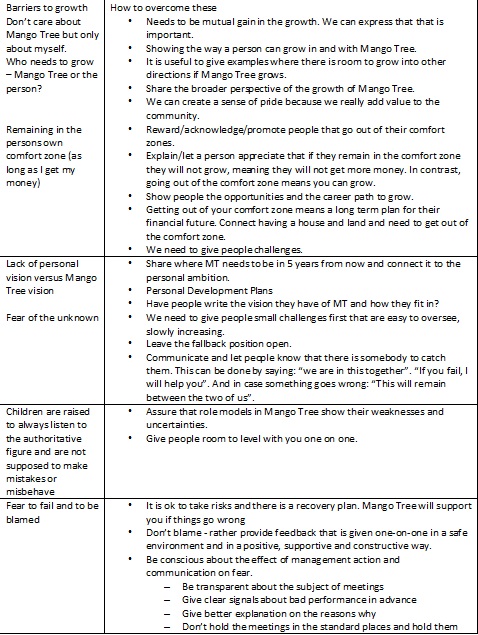Components of the case study
The case study starts with a situational analysis, reflecting on cultural factors as well as the Ugandan human resource situation which both influence the setting in which the company operates. It also discusses the competitiveness of Mango Tree in the human resource market in Uganda. The second part of section 2 examines the internal factors in the organisation that hindered the ability to increase performance. Section 3 describes several interventions that were put in place to improve the internal environment, changing it to a more coaching-friendly environment. The last section discusses the effect and limitations of the interventions, as well as intermediary and long-term expected results.
Situational analysis
Theoretical background
According to Hofstede’s[2] research on cultural differences, East Africa ranks relatively high on power distance, (64 rank 21/23 of 53) low on individualism (27 rank 33/35 of 53), high on masculinity (41 rank 39 of 53) and low on long-term orientation (25 rank 18/20 of 25)
According to Richard D Lewis[3], African culture is typified by: specific rights of kinship, duty (social obligation) cooperation before competition and respect for the elderly. It is important to avoid criticising Africans in front of others, dwelling on African shortcoming and failures, patronising, exploiting economic conditions unduly and firing people. Understanding this gives insight in what kind of management style can be effective in Uganda.
According to Saoirse OMara, the top ten of barriers to personal growth and development[4] are:
- Fear
- Laziness and lack of discipline
- Contentment and routine
- Skepticism
- Lack of support
- Victimising oneself, putting the fault outside of oneself
- Lack of resources
- Guilt
- Lack of self knowledge
- Perfectionism
In this list, the barriers are mostly internal, with the exception of item number 5. In Table 1, the barriers are predominantly related to the interaction between the person and Mango Tree. This brainstorm could to a certain extent be applied to many different companies. It has not been substantiated by an empiric study, however.
In an article regarding drivers and barriers for developing talent in 2013[5], a more integrated and generalised picture is given.
Drivers for developing talent:
Barriers to developing talent:
Strategic opportunities are:
Practical opportunities are:
The groups also prioritise some key needs by thinking about what they would wish for if they had a ‘magic wand’ to support personal development and training needs:
Resources to support these opportunities are:
The overview in this article gives a more complete overview of how an organisation can adapt itself to ensure that it develops talent. It is, however, clearly embedded into a western setting.
Background information regarding Uganda
Uganda has the world’s youngest population with over 78% of the population below the age of 30[6], and about half of the population below 24 years of age.[7] The future well-being of the country depends on creating a new generation of skilled, competent, and responsible adults. Yet the majority of Ugandan youth are at serious risk of not achieving “productive adulthood”. An important aspect of understanding the adequacy of education in the context of poverty and youth is its perceived relevance.
Corporal punishment and absolute authority of elders leads to a fear of punishment and failure. As such, part of Ugandan culture is the difficulty in admitting weak points or failure. Seeing failure as a way to learn is difficult as mistakes are often severely punished. It is challenging for a person to connect situations in the organisation to one’s own functioning and potential steps of improvement. The educational system is based on rote learning. As a result, people who are able to effectively memorise prevail in the Ugandan system. The ability to understand and apply concepts is challenging. In Africa oral and visual communication are the two main ways to communicate. The combination of rote learning and oral and visual communication, however, reduces the ability to implement and work with systems in the organisation.
Young people as well as local government officials and employers in the private sector reported that prospective employees need to be highly educated to access meaningful jobs. They stated that the lack of skill and qualification among youth is not only a result of low level of education attainment, but also related to the weaknesses in education and the lack of vocational training opportunities.[8]
The HR competitiveness of Mango Tree and its HR strategy
Mango Tree is a relatively small organisation that competes with international NGOs for the same human resources but with a smaller budget. Because of this and because Mango Tree is a unique organisation, it brings in people as young as possible. In this way they can be hired from a larger pool of unemployed young people and can be trained from the inside. Consequently, there is a need for constant training, coaching and mentoring. Senior staff must continuously train and mentor people, correct errors and grow people within the organisation.
At the start of the described interventions, around 2011, Mango Tree was for a good portion depending on free lance consultants, volunteers or people who were paid per deliverable. The organization had about 12 people as full time employees.
As part of an internal analysis, Mango Tree did an evaluation with several key members of staff to see what they perceived as key barriers for their own growth. After naming these barriers the participants gave options on how to overcome these barriers. The results of the evaluation are given in Table 1.
Table 1 Brainstorm on barriers to growth and how to overcome these among key Mango Tree members of staff
 The table together with the information from the two articles give interesting insights on how to improve the environment in an organisation to support talent to grow.
The table together with the information from the two articles give interesting insights on how to improve the environment in an organisation to support talent to grow.